There are many ways for investors to profit, but one of the most common methods is to take a “long position.”
Taking a long position essentially means buying a security, such as a stock, with the expectation that it will rise in value. For example, a trader who is bullish on a company might go long on that company with the hope that shares will eventually go up.
Read on for a brief overview of how taking a long position works, and how traders can make money by using this investment strategy to buy and sell shares on the stock market.
What is a long position in investing?
When an investor takes a long position in a stock, the idea is that they will buy shares at a low price and then sell the shares at a higher price. In this investment strategy, an investor who owns 100 shares of a company is said to be long 100 shares.
After taking a long position in a company, an investor would hold the shares and sell them once the stock price has risen. If the company’s stock price drops, but the investor remains optimistic that it will rise again in the future, they might choose to buy more shares at a lower price. Having specific goals or targets can help investors determine when to sell.
Investors who hold long positions in stocks may also be eligible to receive dividends from the companies they have invested in. A dividend is typically paid to shareholders quarterly.
Click here to learn what dividend stocks are, and for details on specific companies that pay dividends, check out Silver Stocks that Pay Dividends, US Oil and Gas Stocks that Pay Dividends and Canadian Oil and Gas Stocks that Pay Dividends.
What’s the difference between long and short positions?
While many investors choose to go long on stocks, it’s also possible to short a stock. Short selling a stock is a type of investment strategy that is considered the opposite of taking a long position. To take a short position, an investor would borrow funds from a broker to buy shares in a company, and essentially bet that a company’s shares will go down.
Sooner or later, the investor must “close” the short position by buying back the same number of shares and returning them to the broker. Bearish investors can make a profit if the company’s shares decline, but if the company’s shares increase in price, the short seller will owe that money to the brokerage firm.
As Investopedia notes, the basic difference between these two investing methods is that long positions are owned, while short positions are owed. A simple long stock position is bullish and anticipates growth, while a short stock position is bearish.
Theoretically, a short sale has a higher risk than taking a long position, as it involves using borrowed money to trade a stock or another asset that could increase in price. Taking a long position also has risks, but they are defined — when going long on a stock, investors can only lose their premium.
Securities Disclosure: I, Melissa Pistilli, hold no direct investment interest in any company mentioned in this article.







































